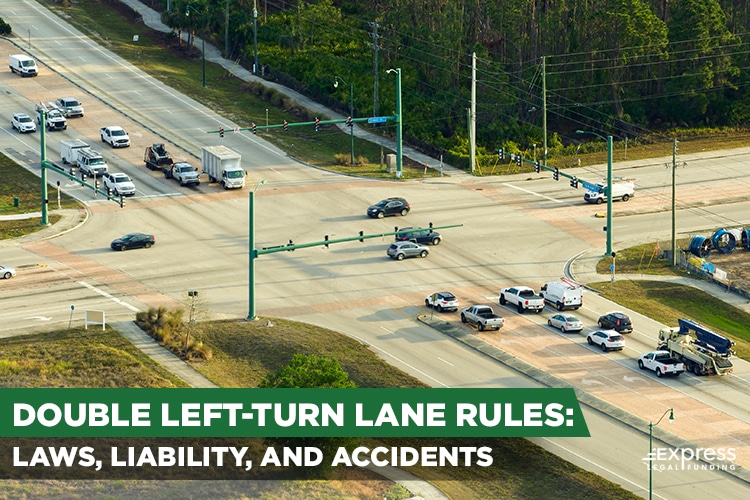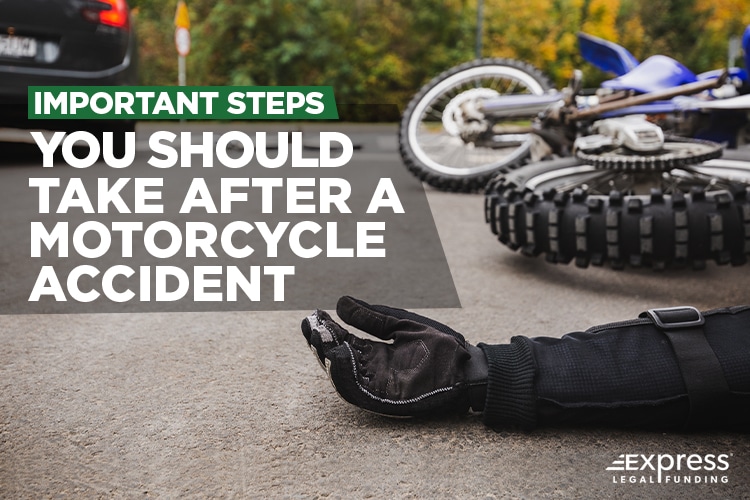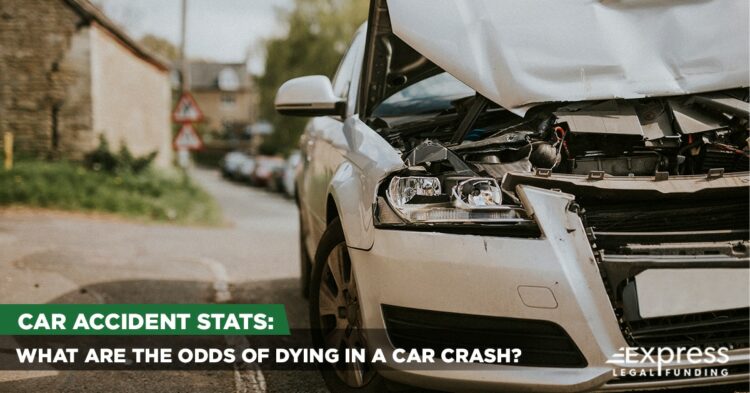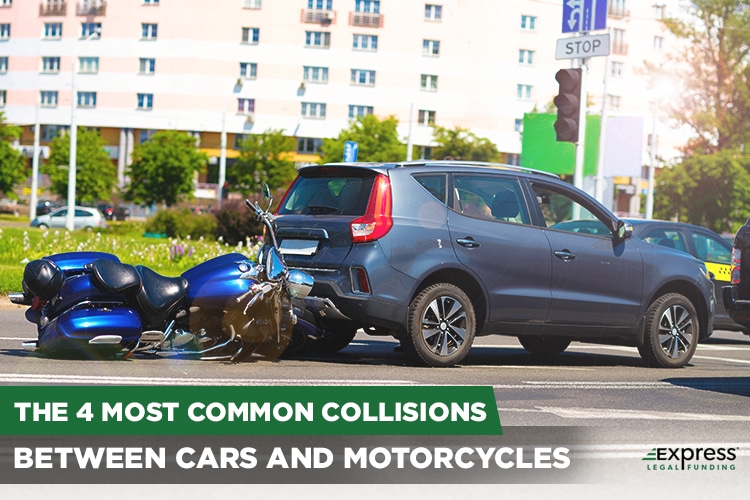
Car and motorcycle accidents happen every day, but when a crash involves a motorcycle, the consequences can be far more severe.
Unlike cars, motorcycles offer little protection, making riders vulnerable to serious injuries.
Understanding the most common types of motorcycle collisions—like left-turn crashes, lane-changing accidents, and rear-end impacts—can help both drivers and motorcyclists stay safer on the road.
In this guide, we’ll break down the most frequent car-motorcycle collisions, what causes them, and how liability is determined.
If you’ve been injured in a motorcycle accident, knowing your legal options is crucial—especially when dealing with medical bills and lost wages. Read on to learn how these accidents happen and what steps you can take to protect yourself.
Collisions Between Cars and Motorcycles
Statistics, such as a Yale University medical study, show motorcycles have a significantly higher chance of their riders suffering severe and fatal injuries.
However, there exist varying opinions concerning the safety of motorcycles among the general population.
Many people, especially those who do not choose to ride motorcycles and prefer to drive a car, view motorcycles as death traps and loud nuisances that make it more hazardous for cars and trucks to drive safely on the road.
In contrast, there are the bikers, the motorcycle riders themselves. They believe riding a two-wheel vehicle on the roads is a liberating experience, which is and should remain their legal right.
The problem is, putting the issue of Constitutional freedom aside, motorcycles are severely lacking in safety features compared to the other vehicles with which they share the road. That is the crux of the issue for those who oppose the legality of motorcycles.
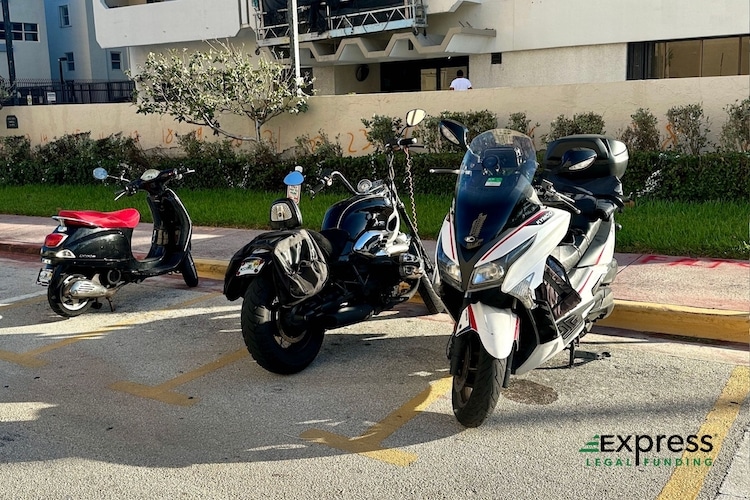
Motorcycles are less protected and smaller than even the most compact cars on the market and are more difficult for other car drivers to see them on the road, making it easier to strike them, which leads to a higher chance of severe wrecks.
Regardless of personal opinions, statistics show that motorcycles are much more dangerous, and their accidents are associated with more serious injuries and a higher chance of death.
What Percentage of Motorcycle Accidents are Fatal?
According to the most recent statistics released by the Fatality Analysis Reporting System (FARS) of the NHTSA, the percentage of motorcycle accidents that are fatal is 5.68%, which is five times the odds of your dying in a car accident.
There Were a Total of 6,082 Fatal Motorcycle Accidents in 2021
Common Severe Motorcycle Injuries
Some of the more severe and most common motorcycle injuries, all of which can be fatal, include:
- Traumatic brain injuries (TBI) – The most fatal injury type
- Spinal cord injuries
- Abdominal injuries
Unarguably, along the same line, countless statistics and studies show cars are safer than motorcycles and have fewer safety risks of injury and a lower rate of fatal wrecks due to the more protective and closed construction of cars.
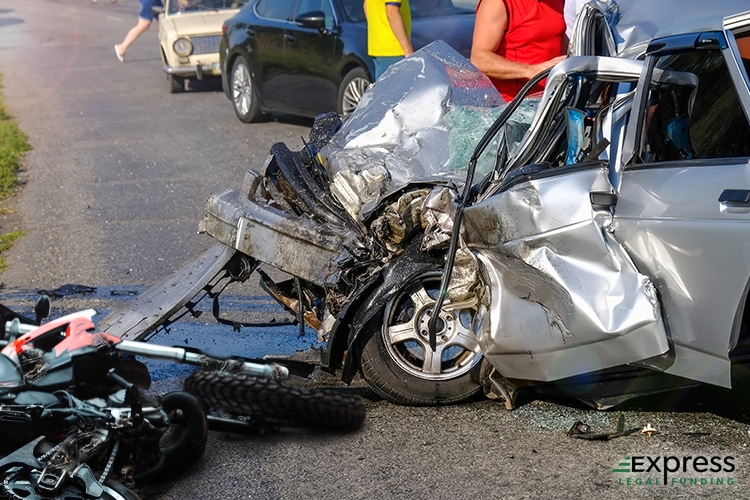
The increased safety risk, combined with a boon in motorcycle sales (with Harley-Davidson leading the market) over the last few years, has led to a higher spike in motor vehicle accidents involving bikers than ever before in the United States, and the establishment of trends.
Over the years, government agencies and insurance companies have continually monitored and analyzed collected data about motor vehicle collisions to identify injury and fatality rates and establish common causes.
For instance, one NHTSA report’s statistical data show that the death rates for motorcycle accidents are nearly 28 times higher than those of passenger cars.
Most Common Causes of Motorcycle Accident Collisions
Studies based on this data have allowed the government to quantify some of the most common types of motorcycle accidents. These dangerous downsides will be the focus of this list article and include the following collision types:
- Head-on Collisions
- Left-hand turns
- Lane-splitting
- Speeding
- Fixed-object collisions
Before discussing the most common causes of motorcycle accidents, let’s define what is considered a motorcycle from a practical perspective and in the eyes of the law.
What is the Legal Definition of a Motorcycle?
Although the licensing and registration requirements for motorcycles vary from state to state, the driver’s license law’s definition of a motorcycle is a two- or three-wheeled vehicle with a minimum engine size of 50cc.
Depending on the state, the legal definition may also include scooters and mopeds.
Collision #1: Head-On Collisions
What is a head-on collision? Head-on collisions occur when two vehicles facing each other strike head-on (frontal collision), which can be devastating when it occurs between two cars driving at high speeds.
An accident like this requires both vehicles to move in opposite directions, which is difficult to accomplish unless one of the motorists is reckless and negligent (i.e., driving barefoot) or found to be responsible for distracted driving (i.e., texting or wearing headphones while driving).
Head-on collision accidents are one of the most common reasons for vehicles to occupy the same lane while going in opposite directions, because one of the drivers is attempting to bypass traffic, which, depending on the circumstances, can involve an illegal lane change.
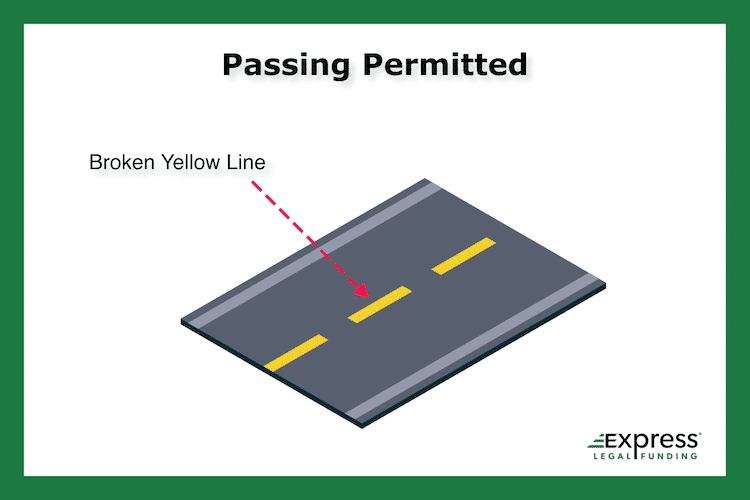
Passing on Two-Lane Roadways
Head-on collision accidents are most common on two-lane roads and highways where cars go in both directions. There is a driving law that allows a driver to pass the motor vehicle driving in front of them by temporarily driving in the left lane reserved for oncoming traffic.
Passing on the left while driving on a two-way road typically works as follows:
When done safely, there are two drivers: Driver A and Driver B.
- Driver A is the car driving in front of Driver B.
- Driver B is the car driving behind Driver A.
When is it Safe to Pass on a Two-Lane Road?
First, to safely pass on a two-way road, the yellow line that divides the two directions in the middle must be a dashed line on your side and not a single unbroken yellow line.
The steps of passing the car ahead of you typically include the following events and are commonly associated with interstate and intrastate highways in rural areas.
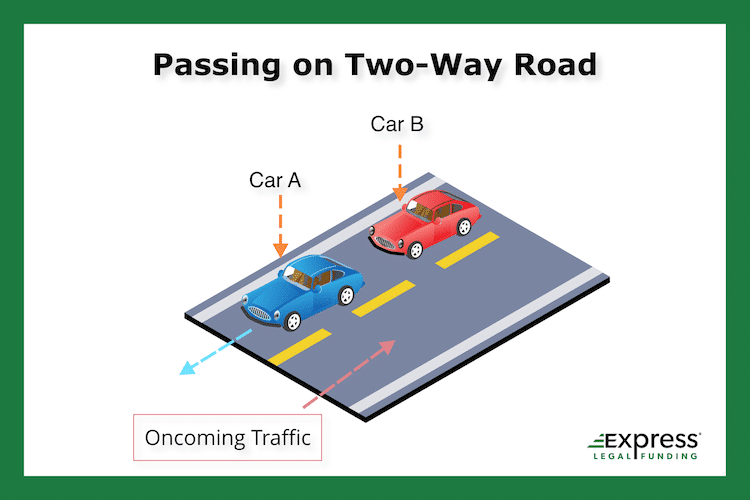
In addition to the following list of changing lanes steps on a two-way road, you can use the above infographic for your visual learning and reference:
- Driver B identifies the car they are cruising behind, Driver A, is going too slow for their liking.
- Driver B decides they need to pass Driver A to get in front of Driver A’s car so they can go faster and are not at the mercy of Driver B going slower, causing the commute to be longer and making them more likely to cause a rear-end accident.
- Driver B looks at the yellow line in the middle of the road and sees it’s a yellow dashed line, which means it is legal for them to temporarily merge into the left lane and speed up to pass the car currently in front. If the line were solid, Driver B would not be allowed to change lanes and pass Driver A.
- Driver B looks into the left lane and sees that there is no upcoming traffic headed their way.
- Driver B turns on the left arrow blinker of their car to signal to the car behind them and any oncoming traffic that they are switching lanes.
- Once Driver B identifies it is safe to, they merge into the lane on their left and step on the gas so they can quickly pass Driver A, who will be temporarily on their right (passenger side).
- After several seconds, Driver B passes Driver A and sees they have enough separation from Driver A’s car behind them on their right, so they turn on the right arrow signal to make Driver A aware that they plan to merge back into the right lane ahead of Driver A.
- Driver B successfully merges back into the right lane and turns off their car’s right arrow blinker.
Although it is a process to safely pass the car ahead of you on a two-lane road or highway, it can be completed safely.
Example: Motorcycle Head-On Collision
However, things can get dicey and dangerous quickly under certain circumstances, often resulting in head-on collisions when things go wrong.
For instance, it could be similar to the above scenario between Drivers A and B.
However, this time, Driver B does not see that there is an oncoming motorcycle and changes lanes prematurely, resulting in a head-on collision with the oncoming motorcycle, causing a severe head-on collision.
As is the case for our head-on motorcycle collision example, all it takes is for one impatient driver to shift lanes to get past the vehicle ahead of them and collide with oncoming traffic.
Unfortunately, depending on your commute route, the chances of this can increase significantly, as interstates and old two-way streets in sparsely populated areas pose a greater safety risk.
However, the common denominator of most head-on collisions is negligent driving.
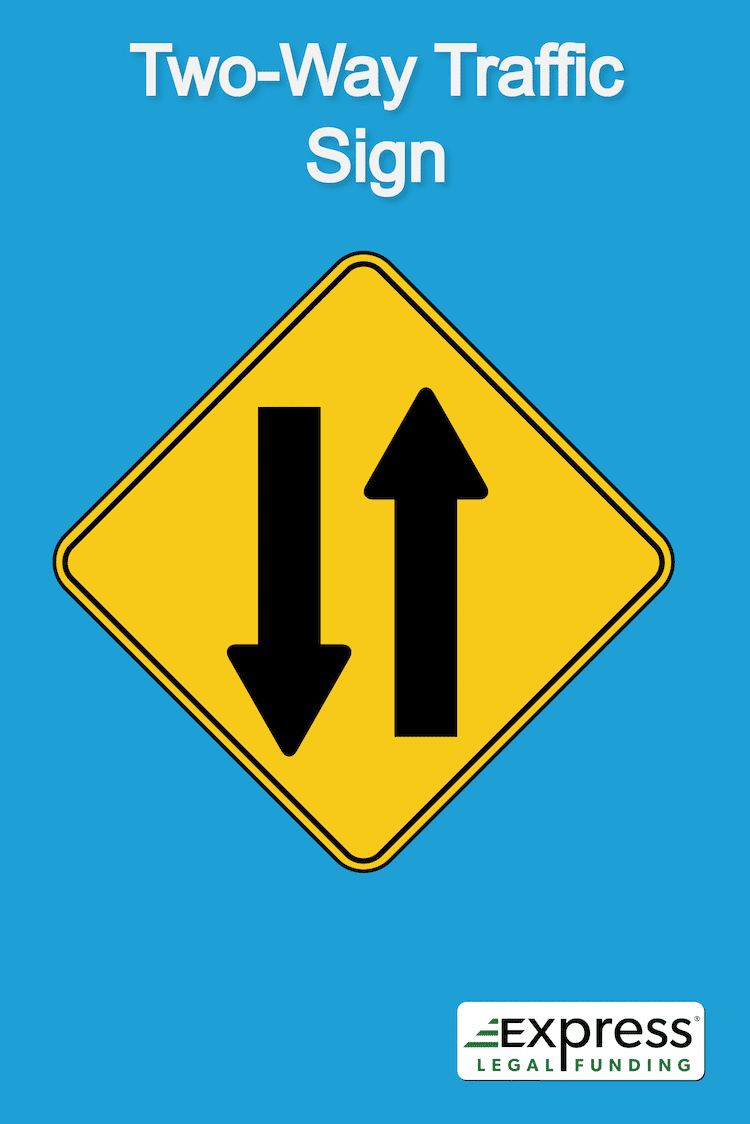
When such a collision occurs between two cars, the injuries vary from moderate to severe depending on the vehicles and their speed at the time of impact.
They are rarely minor, which is all the more the case for motorcycle riders in head-on collisions.
Bikers can expect injuries ranging from severe to fatal in head-on collisions, unlike cars and trucks with crush-resistant cage-like bodies and whose riders are required to wear seatbelts.
Motorcycles lack that protective frame around the vehicle to not keep the biker contained, nor do they have seatbelts and airbags.
As a result, collisions between a car and a motorcycle are known to eject bikers into the air sending them flying dozens of feet before hitting the road.
This drastically increases the odds of severe and fatal injury, even when wearing a helmet and full protective gear, and is why head-first collisions have the highest fatality rate among motorcycle crash types.
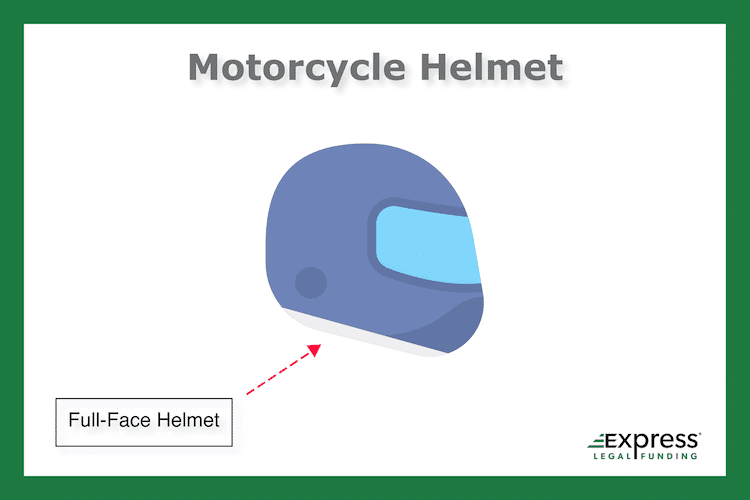
With head-on collisions being first on our list of the most common types of collisions involving motorcycles, let’s move on to number two: Left-turn accidents.
Collision #2: Left-Turns
Left-turn collisions are frequently cited as one of the most common collisions affecting bikers. Left-turn collisions occur when one vehicle attempts a left-hand turn, usually at an intersection, and hits another vehicle moving within close proximity.
Making a turn requires more focus than you might think, especially since the danger lies in how others behave.
While you can always control how you drive and wait until you have the right of way, you cannot control how others behave on the road and prevent others from making reckless driving decisions.
Motorcycles are easier to navigate through traffic than standard cars since they benefit from their smaller size. Motorcyclists weave in and out of traffic, putting narrow distances between them and the cars on the road.
Even when you carefully make a legal left turn at an intersection, someone else on a motorcycle can make a rash and risky driving decision, which makes it next to impossible not to collide with them, regardless of how good your reaction time is.
Motorcyclists (and scooter riders) are at a higher risk of left-turn collisions because they can drive in the spaces between cars.
Although that allows bikers to try and overtake the car ahead of them without fully changing lanes, it significantly increases the chance of a left-hand turn collision if they are trying to make a left-hand turn.
Motorcycles also accelerate faster than most cars, meaning a motorcycle rider could appear in front of you before you register their presence.
As a result, you could drive right into a motorcycle that tried to make the turn before you, rather than waiting for its turn.
Unfortunately, there are other potential causes for a left-turn collision aside from a motorcyclist being reckless and impatient.
Sometimes, left turns are interrupted by a vehicle running the intersection from the lane across from yours.
This recklessness can arise from someone else being careless, and not necessarily a biker.
The fact is that many bikers face significant injuries from these accidents and need skilled representation to ensure they receive rightful compensation for their losses.
It’s crucial they consult with experienced motorcycle accident lawyers to navigate the complexities of the related insurance claims and legal proceedings effectively.
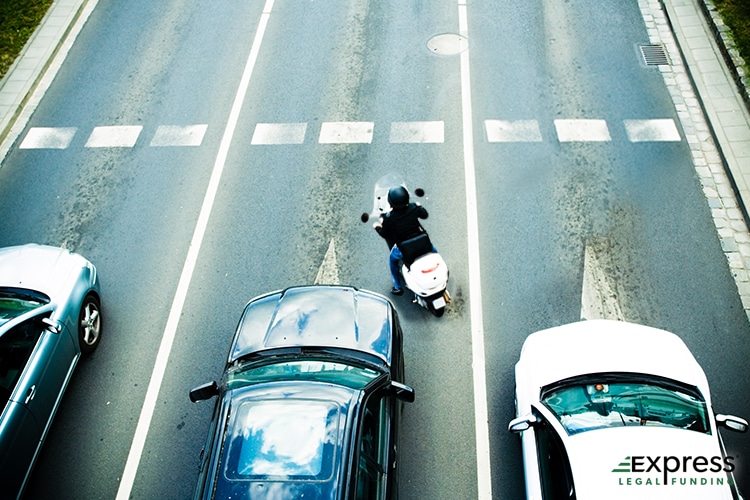
Example: Left-Hand Turn Motorcycle Accident
For example, let us say that a motorcycle rider was making a legal left turn from the bottom section of a 4-way intersection. As they turn, an SUV runs the red light from the upper part of the intersection and hits the biker mid-turn.
Even if the SUV tried to stop and only clipped the rear portion of the motorcycle, it would likely still be a severe collision, resulting in the biker suffering severe injuries or death.
In this example, the SUV is larger and going faster than the motorcycle since it was not in the middle of a left turn.
A Car is More Likely to Hit a Biker While Turning Left
According to the NHTSA (National Highway Traffic Safety Administration), accidents where a car hits a biker turning left account for approximately 42% of all motorcycle-related car accident fatalities, making them one of the most common causes of motorcycle accidents that happen in intersections.
With left-turn collisions being second on our list of the most common types of motorcycle crashes, let’s move on to number three: Lane-splitting accidents.
Collision #3: Lane-Splitting
In a different vein from traditional motor vehicle collisions between two cars, another one of the most common motorcycle accident types is lane-splitting, which we briefly mentioned earlier in the article.
What is Lane-Splitting on a Motorcycle?
Motorcyclists perform lane-splitting when they drive their motorcycles between lanes to get around the larger vehicles on the road.
In densely populated cities with heavy traffic, you often can see ride-share scooters and mopeds lane-splitting to bypass their way to be in front of a pack of cars stopped at a red light. So when the light turns green, the scooters are first in line to go.
Lane Splitting is Illegal in Most States
Although lane splitting is illegal in most states, including Florida, it is very prevalent in some cities, such as Miami, where heavy traffic is an issue and electric scooters are available for rental.
So the reality is that even in states where lane-splitting is prohibited by law, drivers of cars and trucks should be on the lookout for lane-splitting by motorcycles and e-scooters.
Motorcyclists often use lane-splitting to bypass heavy traffic and maintain the high speeds that motorcycles are known for, effectively leveraging the motorcycle’s greater agility than a car.
It is more than just a tactic to navigate through traffic, though, as studies show that lane-splitting reduces the number of motorcycles rear-end collisions, as it allows motorcyclists to control their own road space better and not be subject to the car ahead of them suddenly braking.
However, it’s worth noting that conventional road laws weren’t designed with lane-splitting in mind, which can sometimes put motorcyclists and car drivers in tricky situations.
While being able to drive between lanes might seem like an amazing ability on the surface, it is inherently dangerous and endangers bikers’ lives.
The lane divider lines help drivers recognize where their lane ends and where the other begins so that lane changes can be performed safely. Any vehicle that drives between the lanes is more likely to be struck when another driver begins a lane change.
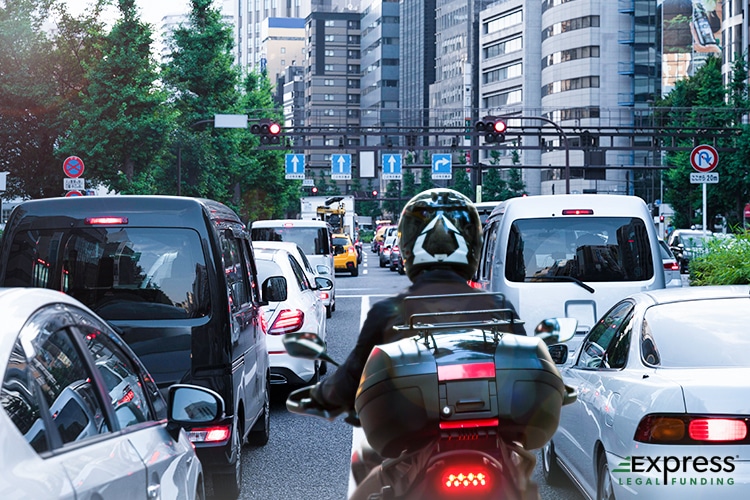
Drivers focus on ensuring there is no incoming traffic in the lane they are trying to transition to, meaning they are not considering the risk of anyone driving between the lanes.
Additionally, even though motorcycles are very maneuverable, they are not good at braking on a second’s notice, unlike cars.
Therefore, when a motorcycle gets too close to a car or has to react to the car in front of them suddenly breaking, the biker immediately breaking themselves is not easy to accomplish safely, especially when traveling at higher speeds.
So the only way the motorcyclist can avoid the stopped car is by veering off to one side.
However, that does not mean there is no open path for them to do so, as it is not unlikely that another car may be in the lane they must move into to avoid rear-ending the car that abruptly stopped.
Example: Lane-Splitting Motorcycle Crash
The chance of a lane-splitting motorcycle accident increases dramatically when the biker is lane-splitting while traveling at higher speeds (e.g., lane-splitting on a highway). An example of a lane-splitting crash could play out as follows.
- A biker is driving between the center and right lanes on a three-lane interstate highway and begins to approach the car on their right.
- The car, which is currently towards the front right of the motorcycle rider, begins to make a legal lane change after the driver checks their side-view mirror and blind spot (They quickly turn their head 90 degrees to the left and look out the driver’s side passenger window.).
After checking and not seeing a car in the center lane, the driver of the car identifies it as safe to proceed and change lanes. - The biker who is lane-splitting moves into the car’s blind spot and does not see the car, which leads to the car sideswiping the motorcycle mid-lane change.
- The sideswipe collision results in the motorcyclist flying off their motorcycle, tumbling forward towards the left, and suffering road burns by sliding across the asphalt.
The above motorcycle crash example was preventable and could have been avoided if not for the biker’s lane-splitting into the blind spot of the car.
If the motorcyclist were driving all the way into the center lane, the driver would have likely seen them since the motorcycle would have been in the driver of the car’s blind spot for a shorter period of time.
Another type of lane-splitting accident can occur, which is known as a “no-contact” accident
What is a No-Contact Motorcycle Accident?
In a no-contact motorcycle accident involving a change of lanes, the motorcyclist does not collide with the car because they manage to swerve out of the way and avoid impact.
However, in the process of avoiding the collision with the car, the biker loses control and wrecks their motorcycle.
Even though there is no impact, the car’s driver can be found to be at fault for causing the no-contact motorcycle accident if their reckless driving caused it.
Unfortunately, these collisions are common enough to be ranked 3rd on our list of the most common collisions for bikers.
With lane-splitting being third on our list of the most common causes of motorcycle accidents, let’s move on to number four: Speeding accidents.
Collision #4: Speeding
As mentioned in this article, motorcycles are superior in accelerating to top speeds than larger vehicles on the road.
This is due to the relatively large engine and high horsepower in relation to the light frames of motorcycles in contrast to cars (although motorcycles are significantly less aerodynamic than cars.)
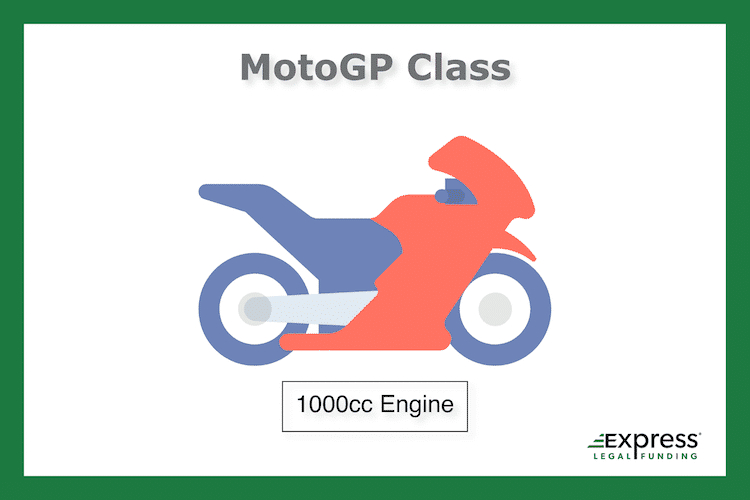
As a result, some motorcycle brands, such as MTT and Kawasaki, specialize in producing motorcycles with significantly better acceleration and top speeds than cars, which means they have an easier time overtaking cars, trucks, and semis.
For instance, the MTT-420 RR can reach a top speed of 273 MPH.
This ability to travel at high speeds enables an intangible advantage: the chemical and psychological connection between riding a high-speed vehicle that can drive quickly and impulsively, using that ability to drive over even the highest legal speed limits.
Speeding is a Common Traffic Violation
Speeding is a common issue with any vehicle, primarily because the human race is impatient.
People speed to reach their destination quicker, whether heading home after a long day at work, rushing to make an appointment on time, or just looking for the exhilaration of high-speed traversal.
This exhilaration is familiar to bikers, who can get an extra rush (so to speak) from speeding because there is no cover on their vehicle, and they can experience the sensation of the wind against them as they drive.
Yet, the sensation of riding a motorcycle is not for everyone.
Many people who regularly ride motorcycles cherish doing so as a hobby or a social activity. Some bikers love the adrenaline rush, which means the faster they drive, the greater the sensation and the higher their euphoria.
Riding a Motorcycle Over the Speed Limit is Dangerous
Unfortunately, not only is speeding a crime and traffic violation, which can lead to fines and jail time, but it is also dangerous.
Those who drive over the speed limit endanger those in other motor vehicles and pedestrians around them. The faster a vehicle goes, the harder it becomes to control and stop.
A motorcycle going at a high velocity can make it almost impossible for the rider to safely make minor course adjustments at a moment’s notice.
Example: Speeding Accident
For example, a motorcycle going 80 miles per hour will have greater difficulty turning slightly to avoid running over a pothole or hitting another car than if it were traveling at 60 miles per hour.
The faster the motorcycle goes, the shorter the reaction time the rider has to brake or swerve out of the way in precarious situations, which increases the chance of crashing.
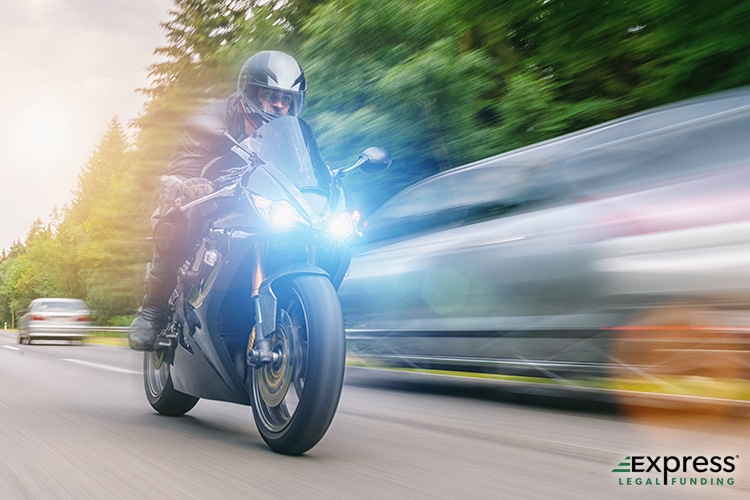
Regarding the design of motorcycles, speeding is even more dangerous because turning at high speeds while going fast makes the bikes more likely to spin out of control and crash.
Braking on a Motorcycle
Additionally, making a sudden stop by braking while speeding is next to impossible for motorcycles, depending on how close they are to the obstacle.
Quickly braking to stop is an easier and safer action for a driver of a car who is not in the middle of turning, since they can slam the brakes and keep the steering wheel straight (a car’s weight acts as a counterbalance, while the seatbelt keeps you from flying out the windshield).
Stopping a motorcycle has a significantly higher risk of spinning out of control since braking a motorcycle is a much more involved process than for someone driving a car.
To safely brake a motorcycle, the biker must identify whether to use the front or back brake and correctly shift their weight brake, which can be challenging while riding at high speeds.
Swerving on a Motorcycle
If motorcyclist finds themself in a situation where the car in front of them suddenly brakes, they must attempt to swerve and brake to avoid the road hazard they are facing, depending on the model of the bike, the speed they are going, and their skill level the momentum could throw them off their bike, resulting in their suffering severe injuries.
Fixed Objects and Motorcycle Road Hazards
Regarding motorcycle traffic incidents, the dynamic between cars and motorcycles is complex and multifaceted.
So far, we’ve discussed four of the most common types of collisions involved in motorcycle accidents and their dangers: head-on collisions, left-hand turns, lane-splitting, and speeding.
However, it’s crucial to emphasize that this list is not all-encompassing, as there are other types of collision risks and factors that pose a threat based on motorcycles’ size and two-wheeled nature.
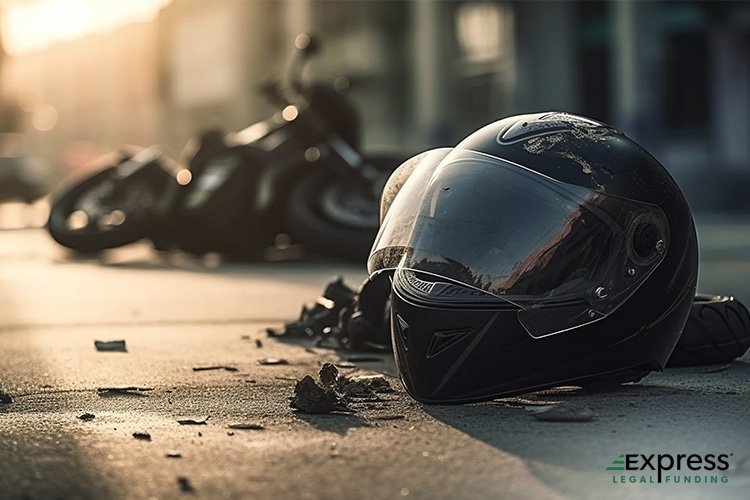
Due to their nimble structure and high-speed capabilities, motorcycles are prone to single-vehicle accidents, which means motorcycle crashes without the direct involvement of cars.
For instance, many collisions occur between motorcycles and fixed objects. According to the latest data, 25% of all fatal crashes involving motorcycles in 2020 resulted from collisions with fixed objects or immovable structures.
Fixed-object motorcycle accidents can include many types of fixed objects that a motorcyclist can crash into (whether by losing control or running into debris in the roadway).
Common Fixed Objects and Debris on the Road
- Guardrail
- Trees
- Broken tree branches
- Grass clippings
- Electrical and telephone poles
- Debris in the road (For example, a broken piece of a car or cargo that fell off a truck)
Ultimately, fixed-object accidents are dangerous and have a fatality rate for motorcycle riders.
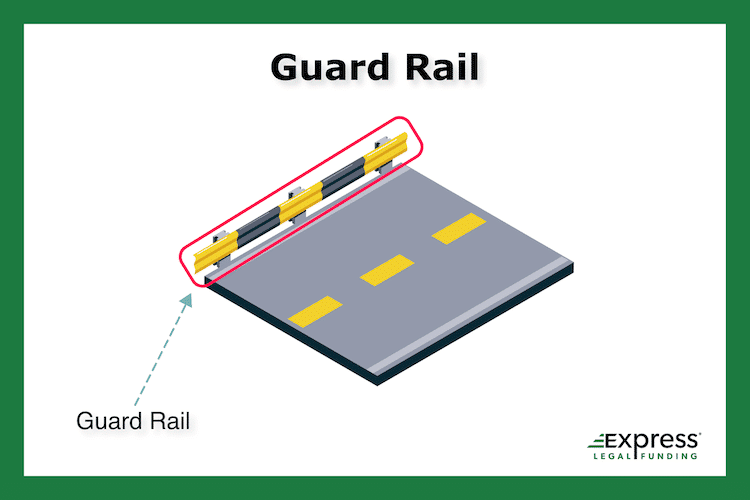
Another and even more deadly cause of fatal motorcycle crashes, as the National Highway Traffic Safety Administration (NHTSA) reported, is that 27% of fatal motorcycle wrecks were associated with drunk driving, which is a higher percentage for any motor vehicle type.
DUI and DWI Motorcycle Accidents
Not only can driving under the influence (DUI) be a felony charge for drunk drivers, it drastically diminishes a rider’s ability to operate the motorcycle safely.
It impairs their judgment, contributing to the driver’s negligence and reckless decision-making, such as exceeding speed limits or ignoring traffic rules.
Moreover, rear-end collisions can be caused at traffic stops and red lights when a car fails to notice a motorcycle stopped ahead.
Understanding the risks and dangers of being a motorcyclist can help you remain vigilant on the road, fostering safer riding conditions for both traditional cars and scooters alike and anyone else involved.
Closing Statements on Common Types of Motorcycle Accidents
The fact is that motorcycle accidents are increasingly common, with almost 90,000 accidents annually.
Motorcycle riders lack the protection of someone riding in a passenger car, meaning it is even more important for them to be extra cautious and demonstrate an extra layer of responsibility.
This problem is made worse by the fact that not every motorcycle accident is the biker’s fault, especially since one of the most common accidents is caused by a car driver’s negligence while not seeing and hitting the motorcyclist during a left-hand turn.
When the motorcycle rider causes the accident by hitting the car you are in, your odds of severe injury are lower than those of the motorcyclist.
Still, you will, at a minimum, suffer light injuries and property damage, such as grade 1 or 2 whiplash and damage to the exterior of your car.
Both of which mean you will incur unforeseen medical bills and car repair expenses that you need to be compensated for.
Motorcycle Accident Settlement
So whether you are the motorcycle rider or the driver of the car in the accident, you will have expenses you will owe money for regardless of whether the wreck was your fault.
Hire a Motorcycle Accident Attorney
The good news is that it is within your rights to seek a free consultation and case evaluation and to hire a personal injury lawyer to file a motorcycle accident lawsuit to recover money for your injuries and damages from the at-fault driver.
Typically, the car or motorcycle insurance company will be the party that actually pays and sends you a settlement check.

The bad news is that even with your ability a file a claim with the help of a motorcycle accident attorney or law firm, obtaining compensation will not happen quickly.
Even the fastest lawsuit settlement processes can be expected to take months to complete, which is an issue when you are short on cash to make your regular payments because of the high cost of surprise medical bills and loss of wages resulting from your being hurt.
The lack of money during a motorcycle or car accident lawsuit is compounded by high inflation, making everything cost more while your dollar buys you less.
In an instant, a motorcycle accident can force you onto a long path of physical recovery, which is all the more likely if you are an injured motorcyclist.
During what could be a several-year treatment process, and is represented by a motorcycle accident lawyer, the chance of your having more expenses than income is not low.
Motorcycle Accident Lawsuit Funding
We at Express Legal Funding understand and have seen this as being the reality for many of our motorcycle accident clients over the years.
Fortunately, this is where we can step in to help you financially during the legal claim process, as we are a pre-settlement funding company, which means we can give you a pre-settlement cash advance now when you need it the most.
What makes pre-settlement funding a unique financial product is that it is not a loan; the money can be provided in the form of a non-recourse purchase agreement, making it a risk-free financial process for you.
We, the legal funding company, are purchasing a portion of your potential case proceeds. It’s an investment for us that means cash in hand for you.
Since investments are never guaranteed, and we are investing in a portion of your case proceeds, we only get paid if you successfully recover money from your claim (whether through a settlement or trial award money).
That means if you get approved lawsuit funding from us and you and your attorney give your best shot and choose to litigate your case in court but lose, you don’t have to pay any of the funds back. That is what makes legal funding “insurance for your settlement.”
By selling us a piece of your case’s potential proceeds, you ensure you access money from your claim, win or lose.
So, if you have an ongoing claim and need money now and not just later when your case ends, pre-settlement funding may be an excellent option for you. You can call us anytime to apply and learn more. We answer 24/7 and are here to help!
(Missouri consumer disclaimer: The type of pre-settlement financing we can provide to injured workers in Missouri is recourse settlement loans. Therefore, they are not risk-free advances contingent upon a potential case proceeds.
Lawsuit loans in states like Missouri are recourse loans and must, technically, by law, be repaid. Express Legal Funding-Missouri, LLC is a loan company licensed to give these loans in MO.)

